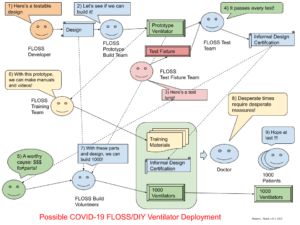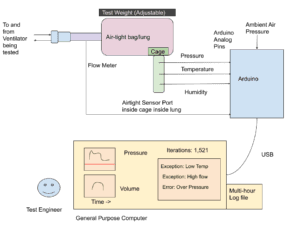In just the last two weeks, America has begun to take strenuous action to slow the COVID-19 pandemic. Adam made a private call for us to answer this challenge, and Bruce Fenton (unknown to me) made a public call. Since Monday I have been working full-time (and a bit more) on this.
Having the advantage of not having a 9-to-5 job, I have become a defacto leader of the Ventilators project at https://www.endcoronavirus.org. EndCoronavirus.org is an effort by NECSI, (Twitter: @necsi) The New England Complex Systems Institute, a group of scientists led by Yaneer Bar Yam (Twitter: @yaneerbaryam ) follow the account at @endcovid19. Mostly, I have been working in the slack: https://necsi-edu.slack.com, in the various channels which begin #response-ventilators.
The purpose of this group is to address the predicted short-fall of ventilators in America and elsewhere in anything other than a best-case scenario. I’m personally proud of the way Americans and Canadians have accepted social distancing as a way to “flatten the curve.” However, I believe there is a 15% chance of an Italy-level catastrophe, where the health care system is overwhelmed and there are not enough ICU beds and ventilators for all who need them. I recruited former PIF Andrea Ippolito to act as a spokesperson, and we were interviewed on Tuesday for BBC Future (article not yet appeared.)
This work forced me to temporarily put aside work on the robot, and also the co-hacking that I was doing with David Jeschke on Math Tablet. My enthusiasm for these projects is not dimmed but diverted. I will continue to support Chris Ferguson and the small Rapid E. coli team.
The Ventilators project has a two-pronged approach: to support manufactures (so far ineffective) and to design an open-source ventilator. There are literally 7,000 people who have offered to help there and at HelpfulEngineering, with about 1000 of them working on Ventilators. At the moment, there is heat without light and noise without harmony; everyone is going in different directions. Few of the open source designs are well-documented; none of them are well-tested; and will go so far as to say most of the engineers building them are ignorant of the clinical needs of ICU patients (as I was 6 days ago.)
To try to add leadership to this, I have taken several actions:
- I created https://github.com/PubInv/covid19-vent-list, a repo listing known open-source-ish ventilator projects, and a very large collection of resources.
- Nariman Poushin and I have asserted that there is a critical need not for yet another ventilator (YAV), but for a test fixture to provide confidence that this life-critical piece of medical equipment is clinically suitable and reliable enough to use. We believe if an open source ventilator is to be ACTUALLY deployed in the Western world, a medical professional will require extraordinary evidence of testing and burn-in. In essence, we are open-sourcing not only the design, but a version of the FDA approval process as well. Our work can be found here: https://github.com/PubInv/ventilator-test-lung-analyzer
- Along with James Trimarco, a statistician in Baltimore, we are attempting to build a data-driven model of ventilator supply and demand. There are MANY news reports about this and NO spreadsheets or python models that accurately combine current data with an SIR or SEIR model of contagion with a model of supplies of ventilators. James is working in Python, I was working in JavaScript, and he will carry forward, but I am shifting to…
- Work on CORVAMP, the CoronaVirus Ventilator Abstract Model and Platform (v 0.1), a model of ventilators which allows software simulation of software design corresponding to hardware designs, in much the same way that VLSI chips exist in simulation before they exist in silicon. This project is just started, but it hopes to educate inventors and give the 1000 people working on this a way to pitch in.


